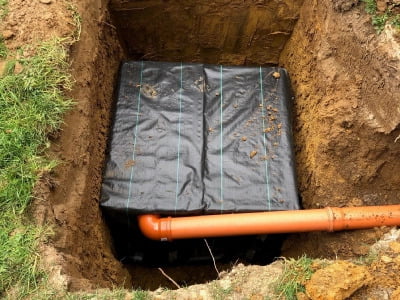A soakaway, also known as a soak pit or infiltration trench, serves a crucial role in efficiently managing rainwater and wastewater from structures and paved surfaces by allowing it to seep gradually into the ground. Its primary purpose is to mitigate flooding and waterlogging by naturally filtering and absorbing excess water, thereby recharging groundwater and alleviating the strain on sewage and drainage systems. Essentially, this allows properties to process and recycle their water independently from public sewers. Soakaways are commonly used for managing rainwater runoff from roofs, driveways, and other hard surfaces.
A soakaway will typically consist of a pit or trench filled with coarse gravel or stone, which allows water to percolate through. A network of pipes or channels directs the water into the soakaway, where it slowly infiltrates the soil. A properly designed and constructed soakaway is crucial, as it ensures the system can handle expected water volumes while safeguarding groundwater from contamination, contributing to the creation and protection of sustainable environments.
Example of how a soakaway is installed.
In the above video, a point is made about needing ample room to install a soakaway. This is something to consider with your own property: not only if you have space, but if the ground is appropriate to hold it, and whether it is worth the cost to dig up the surrounding area to install it. As with any drainage excavation project, care should be taken not to disturb natural processes or wildlife. You can always schedule a consultation with your local planning authority, who can provide information on any local regulations or requirements related to excavation and potential impacts on wildlife. They may also guide you on whether you need planning permission for the installation of a soakaway.
Environmentally friendly and cost-effective, soakaways are an efficient solution for managing surplus water. Soakaways in gardens are a common feature in rural UK drainage systems, especially important in areas prone to heavy rainfall or where the ground has poor drainage characteristics.
Evaluate the characteristics of your property. Do you experience water pooling or flooding during heavy rain? Does the ground remain saturated for extended periods after rainfall? If such issues are prevalent, a soakaway may alleviate them by facilitating the drainage of excess water into the ground.
This may also fall in conjunction with annual rainfall and rainfall patterns in your area. If you live in an area with frequent heavy rainfall, having a soakaway can be instrumental in effectively managing excess water.
The number of impermeable surfaces such as driveways, sidewalks, and patios, on your property can influence the need for a soakaway. If you have a significant amount of these surfaces where water cannot naturally drain through, a soakaway may be necessary to prevent runoff from overwhelming your drainage system.

Assess the functionality of your existing drainage system. If it effectively manages surface water runoff, you may not require a soakaway. However, it is advisable to consult a professional, as there might be underlying factors necessitating a soakaway, such as adhering to government regulations aimed at safeguarding nearby bodies of water from pollution.
The necessity of a soakaway hinges on your specific circumstances and the regulations applicable in your locality. It is advisable to consult your local government or building department to ascertain if there are any rules or prerequisites concerning the management of surface water runoff.
The suitability and design of a soakaway can vary depending on the location of your property, the soil type in the vicinity, as well as other site-specific factors. It’s imperative to take your individual circumstances into account and seek guidance and expertise from local authorities, and you may also find benefits from contacting Grey-Water Drainage Solutions for advice and expert knowledge. This approach then will put you in good stead to determine if a soakaway is needed and, if so, how it should be designed and constructed to comply with local requirements.

